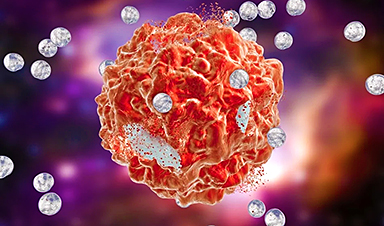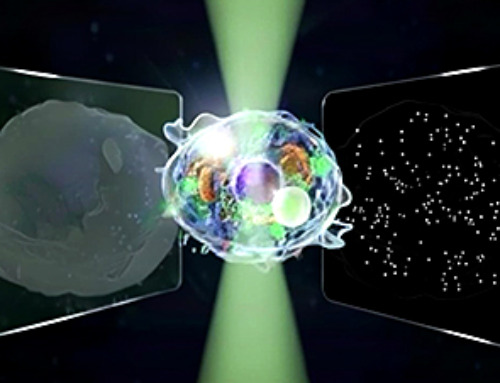A device that applies sound waves to divide and sort minute particles located in the blood within minutes has been developed by Engineers at Duke University. The technology is established on a concept referred to as “virtual pillars” and could be advantageous to scientific research and for medical applications.
Minute biological nanoparticles known as “small extracellular vesicles” (sEVs) are discharged from all types of cells in the body and are supposed to play a huge role in cell-to-cell communication and disease transmission.
The novel technology, labeled Acoustic Nanoscale Separation via Wave-pillar Excitation Resonance (ANSWER for short), is not only capable of pulling these nanoparticles from biofluids within 10 minutes but also is capable of sorting them into size groups that are said to have unique biological roles.
The results were published online in the November 23rd issue of the journal Science Advances.
These nanoparticles have significant potential in medical diagnosis and treatment, but the current technologies for separating and sorting them take several hours or days, are inconsistent, produce low yield or purity, suffer from contamination, and sometimes damage the nanoparticles.
Tony Jun Huang, William Bevan Distinguished Professor, Mechanical Engineering and Materials Science, Duke University
“We want to make extracting and sorting high-quality sEVs as simple as pushing a button and getting the desired samples faster than it takes to take a shower,” Huang added.
New research shows that sEVs contain many subgroups with unique sizes (e.g., smaller than 50 nm, between 60 and 80 nm, and between 90 and 150 nm). Each size is said to have diverse biological properties.
The latest discovery of sEV subpopulations has thrilled scientists because of their potential to transform the domain of non-invasive diagnostics, for example, the early detection of Alzheimer’s disease and cancer. However, the particles are yet to find their way into the clinical environment.
Huang said this is mainly because of the problems related to separating and isolating these nano-sized sEV subpopulations. To overcome this challenge, Huang, his doctoral student Jinxin Zhang, and partners at Harvard, UCLA, and Magee-Womens Research Institute created the ANSWER platform.
The device is fitted with a single pair of transducers to produce a standing sound wave that encloses a narrow, enclosed channel full of fluid. This sound wave “leaks” into the liquid center via the channel walls and interacts with the original standing sound wave. Owing to the careful design of the wall thickness, sound frequency, and channel size, this interaction generates a resonance that produces “virtual pillars” along the channel’s center.
Each of these virtual pillars is fundamentally a half-egg-shaped zone of high pressure. As particles try to cross over the pillars, they are forced toward the channel’s edges. Moreover, the bigger the particles, the bigger the force. By altering the series of virtual pillars to produce nuanced forces on the moving nanoparticles, the scientists can accurately categorize them by size into a range of groups established by the requirements of the current experiments.
The ANSWER EV fractionation technology is the most advanced capability for precise EV fractionation, and it will significantly impact the horizon of EV diagnostics, prognostics, and liquid biopsy
David Wong, Director, Center for Oral/Head and Neck Oncology Research, University of California, Los Angeles
In the new article, the scientists show that their ANSWER platform can effectively categorize sEVs into three subgroups with an accuracy of 96% for nanoparticles on the larger end of the range and an accuracy of 80% for the smallest.
They also demonstrate flexibility in their system, regulating the number of groupings and ranges of sizes with basic updates to the parameters of the sound wave. Each of the experiments just took 10 minutes to perform, whereas other techniques, such as ultra-centrifugation, consume numerous hours or days.
Due to its contact-free nature, ANSWER offers a biocompatible approach for the separation of biological nanoparticles. Unlike mechanical filtration methods, which have fixed separation cutoff diameters, ANSWER offers a tunable approach to nanoscale separation, and the cutoff diameter can be precisely modified by varying the input acoustic power.
Jinxin Zhang, Doctoral Student, Department of Mechanical Engineering and Materials Science, Duke University
News
Very low LDL-cholesterol correlates to fewer heart problems after stroke
Brigham and Women's Hospital's TIMI Study Group reports that in patients with prior ischemic stroke, very low achieved LDL-cholesterol correlated with fewer major adverse cardiovascular events and fewer recurrent strokes, without an apparent increase [...]
“Great Unified Microscope” Reveals Hidden Micro and Nano Worlds Inside Living Cells
University of Tokyo researchers have created a powerful new microscope that captures both forward- and back-scattered light at once, letting scientists see everything from large cell structures to tiny nanoscale particles in a single shot. Researchers [...]
Breakthrough Alzheimer’s Drug Has a Hidden Problem
Researchers in Japan found that although the Alzheimer’s drug lecanemab successfully removes amyloid plaques from the brain, it does not restore the brain’s waste-clearing system within the first few months of treatment. The study suggests that [...]
Concerning New Research Reveals Colon Cancer Is Skyrocketing in Adults Under 50
Colorectal cancer is striking younger adults at alarming rates, driven by lifestyle and genetic factors. Colorectal cancer (CRC) develops when abnormal cells grow uncontrollably in the colon or rectum, forming tumors that can eventually [...]
Scientists Discover a Natural, Non-Addictive Way To Block Pain That Could Replace Opioids
Scientists have discovered that the body can naturally dull pain through its own localized “benzodiazepine-like” peptides. A groundbreaking study led by a University of Leeds scientist has unveiled new insights into how the body manages pain, [...]
GLP-1 Drugs Like Ozempic Work, but New Research Reveals a Major Catch
Three new Cochrane reviews find evidence that GLP-1 drugs lead to clinically meaningful weight loss, though industry-funded studies raise concerns. Three new reviews from Cochrane have found that GLP-1 medications can lead to significant [...]
How a Palm-Sized Laser Could Change Medicine and Manufacturing
Researchers have developed an innovative and versatile system designed for a new generation of short-pulse lasers. Lasers that produce extremely short bursts of light are known for their remarkable precision, making them indispensable tools [...]
New nanoparticles stimulate the immune system to attack ovarian tumors
Cancer immunotherapy, which uses drugs that stimulate the body’s immune cells to attack tumors, is a promising approach to treating many types of cancer. However, it doesn’t work well for some tumors, including ovarian [...]
New Drug Kills Cancer 20,000x More Effectively With No Detectable Side Effects
By restructuring a common chemotherapy drug, scientists increased its potency by 20,000 times. In a significant step forward for cancer therapy, researchers at Northwestern University have redesigned the molecular structure of a well-known chemotherapy drug, greatly [...]
Lipid nanoparticles discovered that can deliver mRNA directly into heart muscle cells
Cardiovascular disease continues to be the leading cause of death worldwide. But advances in heart-failure therapeutics have stalled, largely due to the difficulty of delivering treatments at the cellular level. Now, a UC Berkeley-led [...]
The basic mechanisms of visual attention emerged over 500 million years ago, study suggests
The brain does not need its sophisticated cortex to interpret the visual world. A new study published in PLOS Biology demonstrates that a much older structure, the superior colliculus, contains the necessary circuitry to perform the [...]
AI Is Overheating. This New Technology Could Be the Fix
Engineers have developed a passive evaporative cooling membrane that dramatically improves heat removal for electronics and data centers Engineers at the University of California San Diego have created an innovative cooling system designed to greatly enhance [...]
New nanomedicine wipes out leukemia in animal study
In a promising advance for cancer treatment, Northwestern University scientists have re-engineered the molecular structure of a common chemotherapy drug, making it dramatically more soluble and effective and less toxic. In the new study, [...]
Mystery Solved: Scientists Find Cause for Unexplained, Deadly Diseases
A study reveals that a protein called RPA is essential for maintaining chromosome stability by stimulating telomerase. New findings from the University of Wisconsin-Madison suggest that problems with a key protein that helps preserve chromosome stability [...]
Nanotech Blocks Infection and Speed Up Chronic Wound Recovery
A new nanotech-based formulation using quercetin and omega-3 fatty acids shows promise in halting bacterial biofilms and boosting skin cell repair. Scientists have developed a nanotechnology-based treatment to fight bacterial biofilms in wound infections. The [...]
Researchers propose five key questions for effective adoption of AI in clinical practice
While Artificial Intelligence (AI) can be a powerful tool that physicians can use to help diagnose their patients and has great potential to improve accuracy, efficiency and patient safety, it has its drawbacks. It [...]





















